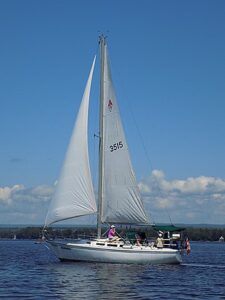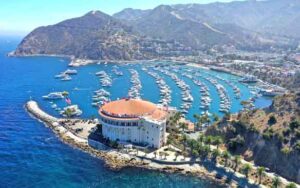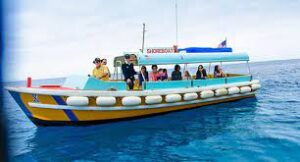Shortly after I moved to California, my sister Sheila and her then-husband Dick moved there from Indiana, as well. Embracing the Southern California lifestyle, Dick became part owner of a 30 foot Catalina sailboat that was moored in Marina Del Rey.
Even though I had never sailed before and new nothing about boats, I became Dick’s regular sailing partner. There was a lot of trial and error in the learning curve as Dick was only one chapter ahead of me in his knowledge of sailing.
This is the story of just one very eventful trip Dick and I took to Catalina. There are multiple chapters to this story.
Chapter One: The Sail out from Marina Del Rey to Avalon on Catalina
The plan was to spend a long weekend on Catalina. We would sail out on Friday and return Sunday. Catalina is about 50 miles due south, 180 degrees from Marina Del Rey. We were lucky in that the wind that Friday was perfect, to the point of almost being too strong. This was that fastest we had ever sailed in the Catalina (Cat 30), a boat built for comfort, not for speed. It was wonderfully exhausting as the gunnels were in the water most of the time. With the boat heeled over to its limit, it meant I was standing on the side wall, not the floor, of the cockpit. The bottom edge of the sail was wet from the constant spray, and so was I. We had planned on the trip taking eight hours, but we made it in about five. Definitely the best time at the helm I ever had.
Chapter Two: Arriving at Catalina
For no other reason than ‘we had never been there’, we first sailed to Two Harbors which is a small village, population less than 300, north of Catalina’s main community, Avalon. Checking Two Harbors off our list, we then sailed to Avalon.
We were optimistic that by arriving earlier than usual on a Friday, we could get a mooring inside the breakwater. As we would be sleeping on the boat, the calm water would be a significant benefit. Our optimism was misplaced. All the sites inside the breakwater were taken so we had no choice but to anchor outside the breakwater, in the open ocean and surrounded by maybe a hundred boats jockeying for space. A couple of points here. To anchor a sailboat, you first drop the anchor. Then using the motor, you back the boat up until the anchor is set (not dragging along the bottom) and the nose of the boat is pointed into the wind. The wind then pushes the boat back on the anchor line and hold it somewhat stable. But before you do any of this, you have to pick your spot carefully. The boat is 30 feet long, but you have to have enough room for the anchor line to stretch out in front of you without risking tangling with another boat. And you also must be mindful of where your boat might end up if the wind changes direction, especially when you are asleep as your boat swings toward those rocks that didn’t seem important earlier in the day.
Oh, and this was the very first time either of us had lowered the anchor, or done any of the stuff needed to anchor in open water. But somehow we got it all done almost as if we knew what we were doing. The boat was secure and we were ready to hail a water taxi to take us to shore. I understood why Dick was so hopeful we could get a mooring inside the breakwater where you could just drive up and tie off to a mooring post. No anchor, no anxiety about wind direction, and no worries about your neighbors, which leads us to the next two chapters of this story.
Chapter Three: Load the Forward Torpedoes!
That night, after enjoying Avalon for a few hours, we returned to the boat, happy and relieved to find it right where we left it. While relaxing in the cockpit with a couple of beers, we suddenly heard a lot of noise and yelling coming from directly in front of our boat. We both jumped up and ran forward to see another sailboat much like ours in size, coming straight for us out of the dark on a collision course, stern first. Chaos ensued. Dick climbed as far forward against the rail at the point of the bow with the hope he could fend off the approaching boat. I scrambled back to the cockpit to start the engine and back us out of danger. At the same time, the people on the other boat (a father and his two teenage sons) were just yelling at each other. Luckily, the father took a clue from Dick’s and my actions and climbed to his stern rail while he yelled to his sons to start their engine. The two boats met in a crunch diminished by the nearly successful opposing efforts of the father and Dick to hold the boats apart. It appeared that neither teenager knew how to start the engine. More yelling ensued. I added to the fun and yelling by shouting attack orders to Dick from the helm. “Load forward torpedoes! Prepare to fire! Get ready to board! Take no prisoners!” It will help you see the humor in this if you picture the incensed, frustrated, and embarrassed father with his arms reaching past and around Dick holding on to our boat while nose to nose with Dick who was in a similar embrace holding on to their boat. Some of us thought I was funny.
Once I had the engine running, I slowly backed us up until there was some space between our boats. Somehow, the anchor didn’t pull loose, so we were still secure. Dick and his counterpart were able to safely let go of their respective boats and the father was able to take over at their helm and pull their boat forward, away from us. Being the obvious expert at anchoring a sailboat, Dick gave them some tips on how to do it effectively, with an emphasis on the part about not crashing into other peoples’ boats. They disappeared into the night and the yelling soon faded as well. We never saw them again on sea or land.
Chapter Four: Does No One Know How To Set an Anchor?
Same night, about 11PM, we were again alerted by commotion, people shouting, and something new, multiple airhorns blasting away. But this time it was no small sailboat that had broken loose, but a massive motor yacht. It was floating backwards toward the breakwater, dragging its anchor chain as it relentlessly lumbered along. Looking up at the stern of the yacht, it looked as high as a three-story building. This thing was huge! This time, we were not in the path of destruction so we got to watch and listen in a more relaxed fashion, once again sitting in the cockpit drinking beer. People were frantically pulling anchor and moving their boats out of the path of disaster. But many boats were unoccupied as their owners were ashore, oblivious to the carnage. The smaller boats that were in the yacht’s path made horrible scraping cracking noises as the yacht plowed into them and shoved them aside. Worse, as it dragged its anchor line through and across the anchor lines of the boats it already hit, the yacht was pulling at least a dozen smaller boats along with it that were banging into each other as they were relentlessly dragged along. And there were people on the yacht! People nearby were yelling at them to start their engines and stop the yacht. But the people aboard were just guests and had no idea how to start the motors. The yacht’s captain had left them aboard while he went ashore.
Better late than never, the Harbor Patrol showed up in their very large (think Coast Guard) ship. They were able to tie on to the yacht’s forward anchor chain and tow it back the way it had come. Unfortunately, the boats with their anchor lines entangled went with them. The yacht disappeared into the darkness as it was pulled eastward, away from the island. We never saw the yacht again.
But we did see the Captain. At least an hour later, we noticed a water taxi with a lone passenger weaving in and out amongst the moored boats. The passenger was a nearly comical stereotype of a civilian captain with white trousers, dark blue double-breasted blazer, a white hat with a shiny brim and an anchor/life preserver emblem. And he may even have had an ascot. He looked and acted like that guy at the mall who can’t remember where he parked the car. We correctly guessed he belonged to the offending yacht. As the water taxi puttered by, we got to tell him the Harbor Patrol had towed his yacht “that-a-way”. We never saw him again, either.
Chapter Five: Getting Lost Going Home
There were some personal dynamics between Dick and me that complicated our return to Marina Del Rey. No need to go into detail, but on this trip, there were two components of this at play. First, Dick was never wrong. And second, as I was the junior officer on the boat, Dick was never wrong.
When it was time to set sail for home, unbeknownst to me Dick reversed our heading to take us back to Marina Del Rey. However, he did not allow for our stop in Two Harbors which is 20 miles north of Avalon. So we were not heading for Marina Del Rey, we were heading for Long Beach, which is 20 miles south of Marina Del Rey.
I didn’t realized the error until I recognized that the Palos Verdes Peninsula was on my left when it should have been on my right. When I suggested we were seeing PV, Dick said I was wrong “Those are the Santa Monica Mountains.” They weren’t. I was right. Dick was wrong. But he did not relent until we were within sight of THUMS Islands, and the very distinctive 180-foot tall oil well structures in the Long Beach Harbor. These towers and the surrounding areas are brightly lit to disguise the oil wells in the harbor. No mistaking them for anything, or anywhere, else.
The trip back had already been slow. With the wind and under sail, the best we could do was five or six knots. We lost the wind before we got to Palos Verdes and had been motoring at an anemic four knots for nearly two hours to get close enough to Long Beach to get Dick to turn around. We were now looking at two additional hours just to get to the western point of Palos Verdes so we could turn north, and two to three hours from there to get to Marina Del Rey. It would be past midnight before we could reach our slip. We motored on with Dick at the helm.
Chapter Six: Kelp!
With Dick at the helm, we sailed right into the famous Palos Verdes kelp forest. Giant kelp so thick that a 30 foot sailboat with a little Volkswagen engine is held fast should one sail into it. Giant kelp plants so long and fibrous that they immediately foul the propeller, stalling the engine of said sailboat. The only solution was to climb into the water and pull the kelp off the propeller allowing us to start the engine and back the boat out of the kelp.
Fortunately for me, Dick and my positions as senior and junior officers respectively had blurred somewhat when Dick sailed us to Long Beach against my protests. So when he suggested I be the one to jump in the water, it took only the gentlest curse-laden refusal from me to convince him that as it was he who had gotten us into this mess, and it was to be him that would get us out. To Dick’s credit, he protested no further and went over the stern, into the water and freed the propeller. With Dick back in the boat drying himself off, I started the engine and were in fact able to back out of the kelp the way we had come in. Even with all of the boat’s running lights on, I was not able to see the kelp bed, so Dick was dispatched to the bow as lookout. We gave the kelp a wide berth and putt-putted our way, albeit hours later, to Marina Del Rey, arriving about half past midnight without further incident.
Chapter Seven: The First and Last
This was both our first and our last overnight sail together. Soon after, I passed the test that allowed me to captain my own (rented) boat. There was a sailboat charter company in Marina Del Rey that had a 32 foot boat that was rigged for solo sailing. It became my go-to boat as it allowed me take non-sailors as passengers without having to press them into service. So, Thank You Dick for introducing me to the joy, challenge and adventure of sailing.


